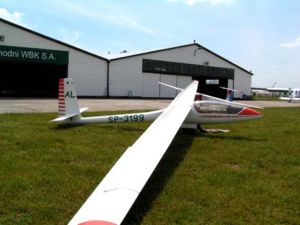PlaneSpottingWorld welcomes all new members! Please gives your ideas at the Terminal.
PZL Bielsko Jantar
| SZD-42A Jantar 2 | |
| Type designation | SZD-37 (prototype) SZD-38A Jantar SZD-42A Jantar 2 SZD-42-2 Jantar 2B |
| Competition class | Open |
| Number built | |
| Crew | 1 |
| Length | 7.11 m |
| Height | 1.76 m |
| Cockpit width | 0.60 m |
| Cockpit height | m |
| Wingspan | 19 m SZD-37 20.5m SZD-42A |
| Wing area | 14.25 m² SZD-42A |
| Aspect ratio | 29.5 SZD-42A |
| Wing profile | FX 67-K-170/160 |
| Empty mass | ca. 343 kg SZD-42A |
| Water ballast | 130 kg SZD-42A |
| Maximum mass | 593 kg SZD-42A |
| Wing loading | ca. 30 - 41.5 kg/m² |
| Maximum speed | 250 km/h (135 kts) |
| Speed in rough air | 160 km/h (86.5 kts) |
| Stall speed | 65 km/h (35 kts) |
| Minimum sink rate | ca. 0.46 m/s |
| Best glide ratio | ca. 47 |
| Roll rate |
(-45 to +45 bank) |
Types like the SZD-31 Zefir 4 and the SZD-24 Foka series had demonstrated that sailplanes of up to date wooden construction could achieve as high a degree of streamlining as any glassfibre designs, and could make their mark in the World Championships and other contests. Perhaps because of this Poland was comparatively late in attempting an all-glassfibre design, the first SZD type in this category being the prototype Open Class SZD-38 Jantar-1 single-seater (or Amber) of 19m span, designed by Dipl-Ing Adam Kurbiel, which first appeared in public at the 1972 World Championships at Vrsac, Yugoslavia, where it came 3rd in the Open Class and won the OSTIV cup for the best 19m design; in the following year it set up seven new Polish national records.
Originally designated SZD-42A, the Jantar 2 high performance Open Class single-seater was developed by Dipl-Ing Adam Kurbiel from the all plastic SZD-38A Jantar-1 of which a small number had been built; the Jantar 2 made its first flight on 2 February 1976. The first two prototypes were flown by the Polish team in the 1976 World Championships in Finland, where they came 2nd and 3rd in the Open Class flown respectively by J. Ziobro and H. Muszczynski. These two Jantars had wings built in two sections whereas the production aircraft have the wings built in four pieces for ease of rigging and trailer transport; one of the latter aircraft, flown by R. Johnson of the USA, came 7th in the Open Class in the 1976 World Championships.
Altogether 23 Jantar 2s had been built by the beginning of 1979, and these differ from the Jantar Standard chiefly in having wings of 20.5m (67'3") span and a low-set tailplane with elevators and no tabs. Up to 287lb of water ballast can be carried, and when it is the g limits of the airframe are +4.0/- 1.5, or +5.3/-2.65 g without the water ballast. The Jantar 2 is of all glassfibre construction very similar to the Jantar Standard; unlike the latter its single-spar wings are of ribless construction with foam filled glassfibre/epoxy resin sandwich skin incorporating hingeless trailing edge flaps hung from the upper surfaces, as well as light alloy DFS-type air brakes in both the upper and lower wing surfaces. The fuselage is an all-glassfibre/epoxy resin shell structure, the centre portion of which has a steel tube frame which couples the wings, fuselage and landing gear. The cantilever tail unit is of glassfibre/epoxy resin and there is a retractable monowheel and a tailskid instead of a tailwheel.
Latest version is the SZD-42-2 Jantar 2B, which is very similar to the Mk 2 but with the wings raised from the mid to the shoulder position and the incidence reduced slightly. Up to 375lb of water ballast can now be carried, and the Jantar 2B features improvements to cockpit comfort, the monowheel retraction system and the elevator spring trim; there is provision for a towing hook on the cg. The Jantar 2B made its first flight on 13 March 1978 and 32 had been built by the beginning of 1980.

